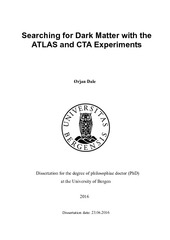Searching for Dark Matter with the ATLAS and CTA Experiments
Doctoral thesis

Åpne
Permanent lenke
https://hdl.handle.net/1956/12701Utgivelsesdato
2016-06-23Metadata
Vis full innførselSamlinger
Sammendrag
The existence of dark matter has been inferred by several experiments through measurements of its gravitational effects. However, dark matter has not been observed directly, meaning that we do not know what it is made of. Furthermore, the Standard Model of particle physics does not contain a viable dark matter candidate, making new physics beyond the Standard Model necessary to explain dark matter. One possible candidate for particle dark matter is Weakly Interacting Massive Particles (WIMPs). Supersymmetry is an extension of the Standard Model where WIMPs frequently arise. In this thesis two methods of searching for dark matter are investigated. One involves searching for the production of supersymmetric particles at the Large Hadron Collider (LHC), and the other searching for annihilation products of naturally occurring WIMPs with the planned experiment Cherenkov Telescope Array (CTA). The main part of this thesis, Part II, is devoted to presenting two searches for supersymmetry using data collected by the ATLAS experiment at the LHC at CERN. In both analyses, supersymmetric events are searched for in final states containing jets, Emiss T , and at least one τ lepton. The first search is performed using 4.7 fb−1 of data collected at a centre of mass energy of 7 TeV during 2011. The second search makes use of 20.3 fb−1 of data collected at a centre of mass energy of 8 TeV in 2012. As no excesses with respect to the Standard Model expectations are observed in either of the searches, upper limits on contributions from new physics are derived. The results are also interpreted in the context of different supersymmetric models, and exclusion limits are set on the model parameters. In the last part of the thesis, Part III, the expected sensitivity of CTA to WIMP annihilations into monochromatic photon pairs in the Galactic Centre is evaluated. When comparing the projected sensitivity to results from current experimental facilities, it is found that CTA should provide more stringent exclusion limits across a wide range of WIMP masses than achieved by current experiments.